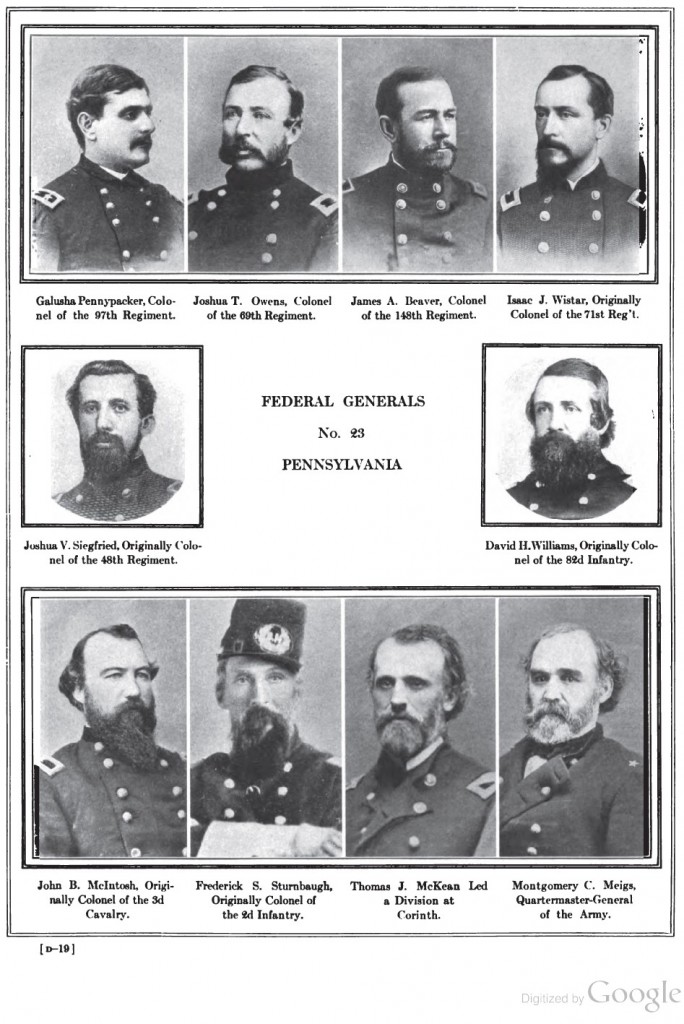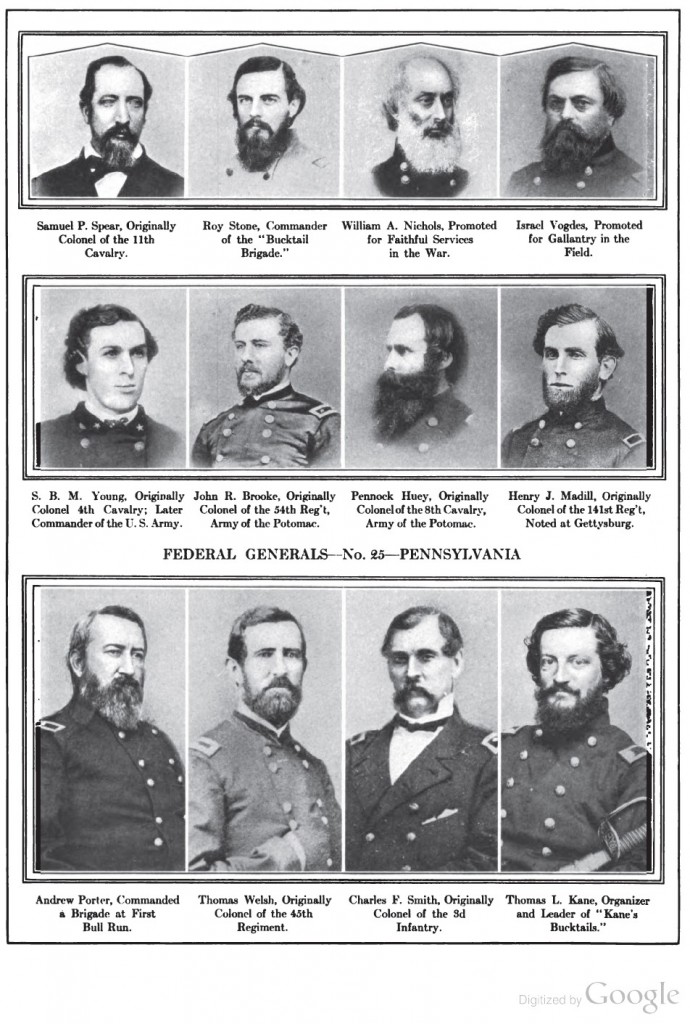Armies and Leaders
Posted By Norman Gasbarro on February 11, 2011
(Part 11 of 12). Contents of Volume X of The Photographic History of the Civil War: Armies and Leaders.
The year 1911 was the 50th anniversary of the beginning of the Civil War. In a memorial to the war, a ten volume set of books was published entitled The Photographic History of the Civil War. This series attempted, through photographs, to do what no other books had previously done – to bring the war close and personal through previously unpublished and unavailable photographs. The series was edited by Francis Trevelyan Miller.
This post is part 11 of a 12 part series and will focus on the contents of Volume X, Armies and Leaders.
Contents of Volume X of The Photographic History of the Civil War.
“Introduction,” Robert S. Lanier. “Ulysses Simpson Grant,” William Conrad Church. “Robert E. Lee,” William Peterfield Trent. “William Tecumseh Sherman,” Walter L. Fleming. “Stonewall Jackson,” Allen C. Redwood.
“Losses in the Battles of the Civil War – Their Meaning,” Hilary A. Herbert. “Casualties of Great European Battles.” “Battles and Casualties of the Civil War,” Gen. Marcus J. Wright. “Troops Furnished to the Union Army by the States.” “Casualties in the Union and confederate Armies.” “Summaries of Organizations in the Two Armies.” “Regimental Casualties in the Union Army.” “Some Striking Confederate Losses.”
“The Federal Armies: The Corps and Their Leaders.” “The Confederate Armies and Generals.”
The Organizations of the Veterans. “The Grant Army of the Republic,” John E. Gilman. “United Confederate Veterans,” Samuel A. Cunningham.
“General Officers, Union and Confederate – A Complete Roster.”
Index [a comprehensive index to all ten volumes].
As suggested by the title, and confirmed by the Table of Contents, this volume focuses heavily on the organization of the armies of both sides and the leadership of those armies – the generals. To understand how an army was organized, a previous post focused on the Union’s Army of the Potomac and provided a chart showing the various subdivisions that made up the army. This volume affirms that the Army of the Potomac was one of many such armies making up the federal forces in the war; the other armies had similar organization. In practice, the Union Army numbered the “corps” that made up its “army” organization. The various armies usually took on the name of the region, military district, or department in which they operated. Thus, the Army of the Potomac, was a consolidated army consisting of the Department of Washington and the Department of Northeastern Virginia. The Army of the Tennessee was an evolving configuration consisting of Military Districts of Cairo and West Tennessee and the Department of Mississippi – which soon became the Department of Tennessee (including Cairo, western Kentucky and Tennessee, and northern Mississippi). Later in the war, the Department of Mississippi was organized to include Departments of Ohio, Tennessee, Cumberland and Arkansas. Nevertheless, despite the name changes and reorganization, commanders following Brig. Gen. Ulysses S. Grant generally referred to the army as “The Army of the Tennessee.”
What is important in this Civil War Research Project that focuses on the men who served from the Lykens Valley area of Pennsylvania, is that for the most part, the records of these men are found in the “regiments” in which they served – and not in the “armies” in which they fought. But for the most part, the actions in which they took part must be seen in the context of the strategies and engagements of the “army” in which they were a part. Broad narratives on the war generally ignore the “regiment” in favor of the “army.” This volume is therefore very useful in sorting out the components that made up each army, although it does not give the names of specific regiments as parts of armies. Most regimental histories will indicate the army in which the regiment was included. In following a particular soldier through the war, first determine the regiment, then consult the regimental history – which should indicate the army to which that regiment was assigned. Regimental engagements (battles, skirmishes, etc.) and casualties are usually listed in the regimental histories. Battle maps can be consulted to determine the specific placement of the regiment during the battle. It is through this way that that stories can be written with some degree of accuracy as to what the individual soldier actually saw and did during the battle or engagement and what contribution he made to the war effort.
This volume contains many pictures of the generals on both sides as well as a listing of all who held that rank. Three pages show portraits of many of the Pennsylvania generals. Those pages are shown below. To see more detail, click on the picture to enlarge.


 FEDERAL GENERALS No. 23 PENNSYLVANIA: Galusha Pennypacker, 97th Pennsylvania Infantry; Joshua T. Owens, 69th Pennsylvania Infantry; James A. Beaver, 148th Pennsylvania Infantry; Isaac J. Wistar, 71st Pennsylvania Infantry; Joshua K. Sigfried, 48th Pennsylvania Infantry; David H. Williams, 82nd Pennsylvania Infantry; John B. McIntosh, 3rd Pennsylvania Cavalry; Frederick S. Stumbaugh, 2nd Pennsylvania Infantry; Thomas J. McKean; Montgomery C. Meigs, Quartermaster-General of the Army.
FEDERAL GENERALS No. 23 PENNSYLVANIA: Galusha Pennypacker, 97th Pennsylvania Infantry; Joshua T. Owens, 69th Pennsylvania Infantry; James A. Beaver, 148th Pennsylvania Infantry; Isaac J. Wistar, 71st Pennsylvania Infantry; Joshua K. Sigfried, 48th Pennsylvania Infantry; David H. Williams, 82nd Pennsylvania Infantry; John B. McIntosh, 3rd Pennsylvania Cavalry; Frederick S. Stumbaugh, 2nd Pennsylvania Infantry; Thomas J. McKean; Montgomery C. Meigs, Quartermaster-General of the Army.
FEDERAL GENERALS No. 24 PENNSYLVANIA: Thomas H. Rowley, 102nd Pennsylvania Infantry; Charles T. Campbell, 1st Pennsylvania Artillery; James Nagel, 48th Pennsylvania Infantry; Alexander Schimmelpfenig, 14th Pennsylvania Infantry; George A. McCall, Pennsylvania Reserves; Albert L. Lee, Cavalry; Joshua B. Howell, 85th Pennsylvania Infantry.
FEDERAL GENERALS No. 25 PENNSYLVANIA: Samuel P. Spear, 11th Pennsylvania Cavalry; Roy Stone, “Bucktail Brigades;” William A. Nichols; Israel Vogdes; S. B. M. Young, 4th Pennsylvania Cavalry; John R. Brook, 54th Pennsylvania Infantry; Pennock Huey, 8th Pennsylvania Cavalry; Henry J. Madill, 141st Pennsylvania Infantry; Andrew Porter; Thomas Welsh, 45th Pennsylvania Infantry; Charles F. Smith, 3rd Pennsylvania Infantry; Thomas L. Kane, “Kane’s Bucktails.”
[Pennsylvania regimental indications refer to the original service of the general before promotion, usually serving with the rank of colonel].
For a free download from Google Books, click here and select “PDF” in the upper right corner of the page. When the “PDF” file opens in your reader, save the file to disk. Use of the file is subject to restrictions that are spelled out on the first page of the PDF. Essentially, the restrictions specify that the digital book may be used for personal, non-profit use only and that the Google Books “watermark” should not be removed from the pages.
On Monday, the 12th and final part of this series will have some index references to Pennsylvania regiments that are included in the series.
 ;
;



Comments